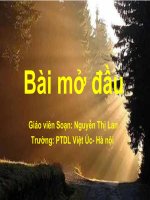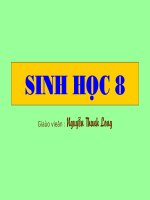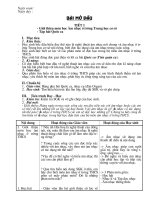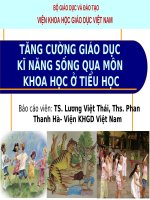Bản sao của bài mở đầu
Bạn đang xem bản rút gọn của tài liệu. Xem và tải ngay bản đầy đủ của tài liệu tại đây (4.52 MB, 62 trang )
SINH HỌC TẾ BÀO
Huỳnh Duy Thảo
Bm Mô – Phôi – Di truyền
MỤC TIÊU
◼ Hiểu được định nghĩa về tế bào.
◼ Liệt kê được các phương pháp nghiên cứu tế bào.
◼ Giải thích được các học thuyết về tế bào.
◼ Giải thích được các thuộc tính của tế bào.
◼ Phân tích được mục tiêu của mơn học.
◼ Phân tích được mục tiêu của môn học
The Nobel Prize in Physiology or Medicine 2011
Bruce A. Beutler
Jules A. Hoffmann
Ralph M. Steinman
The Nobel Prize in Physiology or Medicine 2011 was divided, one half jointly to Bruce A. Beutler and Jules A. Hoffmann
"for their discoveries concerning the activation of innate immunity" and the other half to Ralph M. Steinman "for his
discovery of the dendritic cell and its role in adaptive immunity".
The Nobel Prize in Physiology or Medicine 2012
Sir John B. Gurdon
Shinya Yamanaka
The Nobel Prize in Physiology or Medicine 2012 was awarded jointly to Sir John B. Gurdon and Shinya
Yamanaka "for the discovery that mature cells can be reprogrammed to become pluripotent"
The Nobel Prize in Physiology or Medicine 2013
James E. Rothman
Randy W. Schekman
Thomas C. Südhof
The Nobel Prize in Physiology or Medicine 2013 was awarded jointly to James E. Rothman,
Randy W. Schekman and Thomas C. Südhof "for their discoveries of machinery regulating
vesicle traffic, a major transport system in our cells".
The Nobel Prize in Physiology or Medicine 2014
John O'Keefe
May-Britt Moser
Edvard I. Moser
University College,
Centre for Neural Computation,
Kavli Institute for
London,
Trondheim,
Systems Neuroscience,
United Kingdom
Norway
Trondheim,
Norway
The Nobel Prize in Physiology or Medicine 2014 was divided, one half awarded to John O'Keefe, the other half
jointly to May-Britt Moser and Edvard I. Moser "for their discoveries of cells that constitute a positioning system in
the brain".
TẾ BÀO CỦA CHÚNG TA CÓ TỪ
ĐÂU ?
TẾ BÀO
TẠO->
NHƯ
NÀO ?
TỪCĨ
TẾCẤU
BÀO
CƠTHẾ
THỂ
NGHIÊN CỨU TẾ BÀO BẰNG
CƠNG CỤ GÌ ?
KÍNH HIỂN VI
BẠN ĐỒNG HÀNH
CỦA NGÀNH SINH HỌC TẾ BÀO
KÍNH HIỂN VI
◼PHẦN TỰ HỌC
◼Xem giáo trình: “Sinh học Tế bào”
- Trang 6 – 8/ Bài 1: Nhập môn Sinh học tế bào – Phân tử.
1st Century - Romans were experimenting with glass and found objects appeared larger when
viewed through this new material.
12th Century - Salvino D'Armate from Italy made the first eye glass, providing the wearer
with an element of magnification to one eye.
1590 - Two Dutch spectacle makers, Zacharias Jansen and his
father Hans started experimenting by mounting two lenses in a
tube, the first compound microscope.
Zacharias Jansen
1609 - Galileo Galilei develops a compound microscope with a
convex and a concave lens.
Robert Hooke
1665
-
Robert
“Micrographia”
Hooke's
officially
book
documented
called
a
wide
range of observations through the microscope.
Anton van Leeuwenhoek
1674 - Anton van Leeuwenhoek used his knowledge of grinding lenses to
achieve greater magnification which he utilised to make a microscope, enabling
detailed observations to be made of bacteria.
KÍNH HIỂN VI
◼Quang học
▪ Sử dụng nguồn ánh sáng thơng thường
▪ Độ phóng đại thấp
◼ Điện tử
▪ Quét: quan sát bề mặt vật thể
▪ Xuyên: quan sát bên trong vật thể
▪ Độ phóng đại từ 100.000- 1.000.000 lần
LỊCH SỬ
NGHIÊN CỨU VÀ PHÁT TRIỂN
SINH HỌC TẾ BÀO
Robert Hooke (1665)
◼Cha đẻ của thuật ngữ – “cell - tế bào”
Anton Von Leeuwenhoek (1674)
◼Phát hiện “tế bào prokaryotes”









